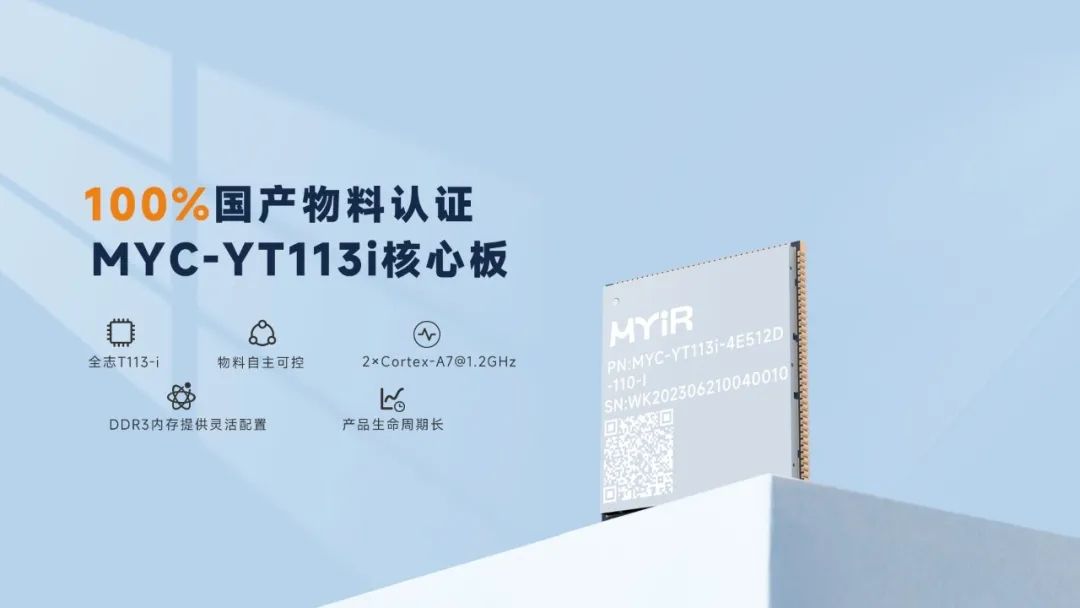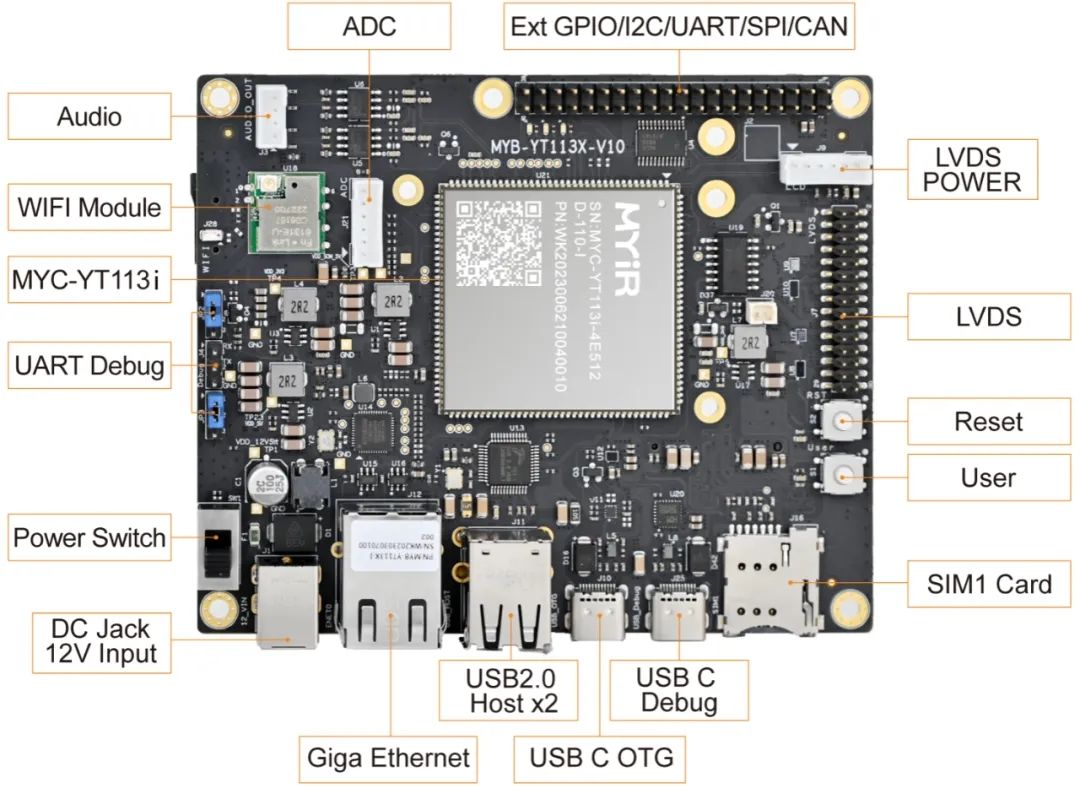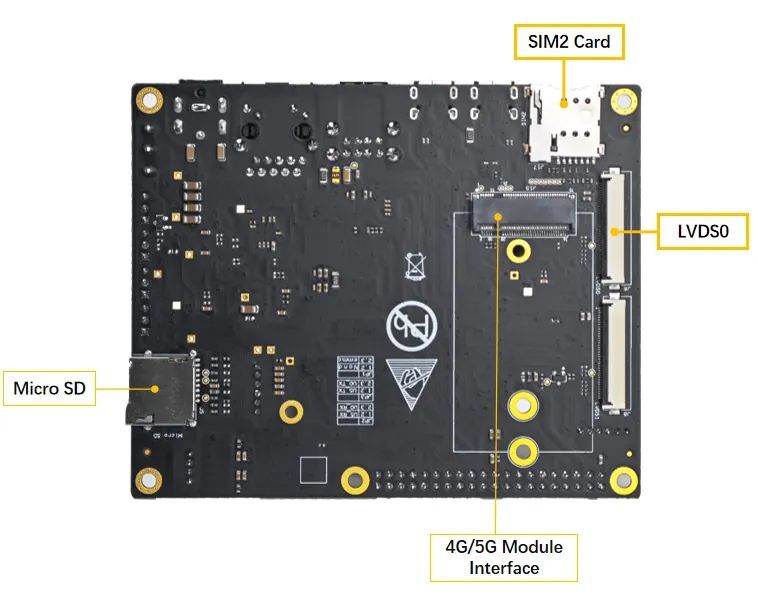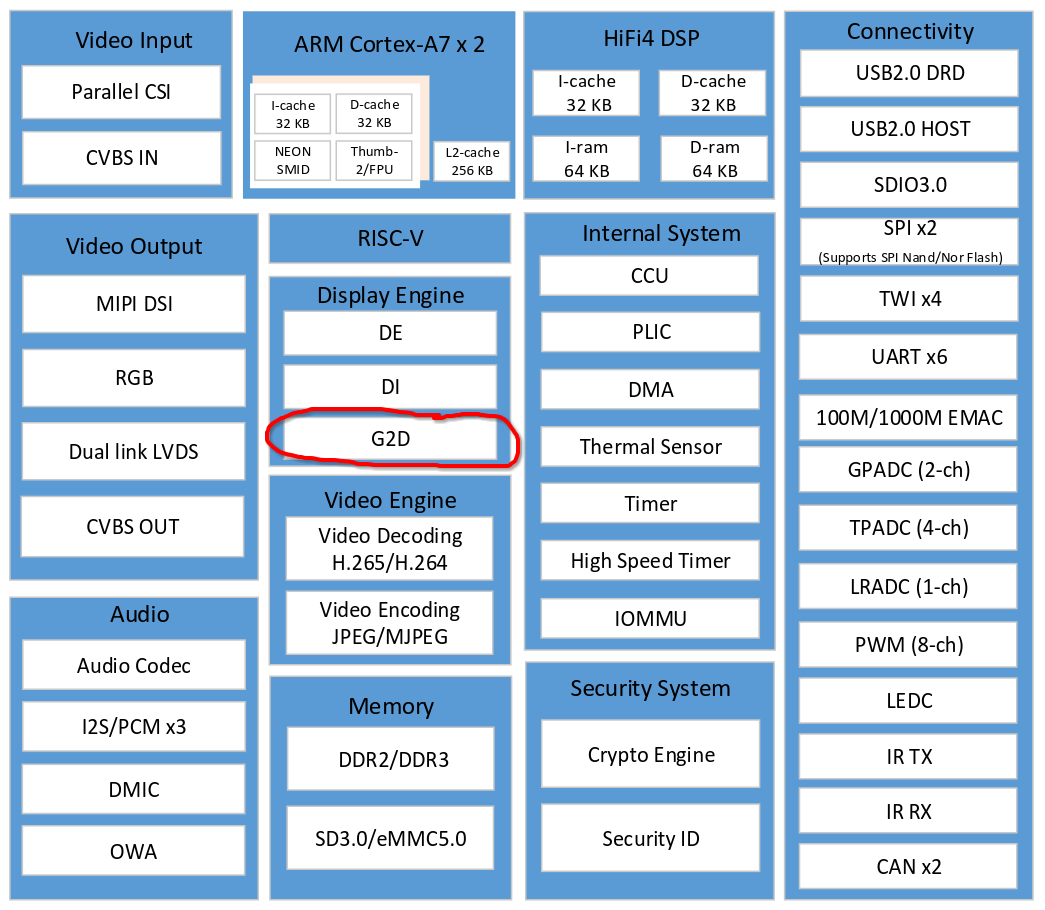G2D图像处理硬件调用和测试-基于米尔全志T113-i开发板

2024-04-09

1846

来源:米尔电子
本篇测评由电子工程世界的优秀测评者“jf_99374259”提供。
本文将介绍基于米尔电子MYD-YT113i开发板的G2D图像处理硬件调用和测试。
MYC-YT113i核心板及开发板
真正的国产核心板,100%国产物料认证
国产T113-i处理器配备2*Cortex-A7@1.2GHz ,RISC-V
外置DDR3接口、支持视频编解码器、HiFi4 DSP
接口丰富:视频采集接口、显示器接口、USB2.0 接口、CAN 接口、千兆以太网接口
工业级:-40℃~+85℃、尺寸37mm*39mm
邮票孔+LGA,140+50PIN



全志 T113-i 2D图形加速硬件支持情况
Supports layer size up to 2048 x 2048 pixels
Supports pre-multiply alpha image data
Supports color key
Supports two pipes Porter-Duff alpha blending
Supports multiple video formats 4:2:0, 4:2:2, 4:1:1 and multiple pixel formats (8/16/24/32 bits graphics
layer)Supports memory scan order option
Supports any format convert function
Supports 1/16× to 32× resize ratio
Supports 32-phase 8-tap horizontal anti-alias filter and 32-phase 4-tap vertical anti-alias filter
Supports window clip
Supports FillRectangle, BitBlit, StretchBlit and MaskBlit
Supports horizontal and vertical flip, clockwise 0/90/180/270 degree rotate for normal buffer
Supports horizontal flip, clockwise 0/90/270 degree rotate for LBC buffer
可以看到 g2d 硬件支持相当多的2D图像处理,包括颜色空间转换,分辨率缩放,图层叠加,旋转等

开发环境配置
基于C语言实现的YUV转RGB
这里复用之前T113-i JPG解码的函数
void yuv420sp2rgb(const unsigned char* yuv420sp, int w, int h, unsigned char* rgb)
{
const unsigned char* yptr = yuv420sp;
const unsigned char* vuptr = yuv420sp + w * h;
for (int y = 0; y < h; y += 2)
{
const unsigned char* yptr0 = yptr;
const unsigned char* yptr1 = yptr + w;
unsigned char* rgb0 = rgb;
unsigned char* rgb1 = rgb + w * 3;
int remain = w;
#define SATURATE_CAST_UCHAR(X) (unsigned char)::std::min(::std::max((int)(X), 0), 255);
for (; remain > 0; remain -= 2)
{
// R = 1.164 * yy + 1.596 * vv
// G = 1.164 * yy - 0.813 * vv - 0.391 * uu
// B = 1.164 * yy + 2.018 * uu
// R = Y + (1.370705 * (V-128))
// G = Y - (0.698001 * (V-128)) - (0.337633 * (U-128))
// B = Y + (1.732446 * (U-128))
// R = ((Y << 6) + 87.72512 * (V-128)) >> 6
// G = ((Y << 6) - 44.672064 * (V-128) - 21.608512 * (U-128)) >> 6
// B = ((Y << 6) + 110.876544 * (U-128)) >> 6
// R = ((Y << 6) + 90 * (V-128)) >> 6
// G = ((Y << 6) - 46 * (V-128) - 22 * (U-128)) >> 6
// B = ((Y << 6) + 113 * (U-128)) >> 6
// R = (yy + 90 * vv) >> 6
// G = (yy - 46 * vv - 22 * uu) >> 6
// B = (yy + 113 * uu) >> 6
int v = vuptr[0] - 128;
int u = vuptr[1] - 128;
int ruv = 90 * v;
int guv = -46 * v + -22 * u;
int buv = 113 * u;
int y00 = yptr0[0] << 6;
rgb0[0] = SATURATE_CAST_UCHAR((y00 + ruv) >> 6);
rgb0[1] = SATURATE_CAST_UCHAR((y00 + guv) >> 6);
rgb0[2] = SATURATE_CAST_UCHAR((y00 + buv) >> 6);
int y01 = yptr0[1] << 6;
rgb0[3] = SATURATE_CAST_UCHAR((y01 + ruv) >> 6);
rgb0[4] = SATURATE_CAST_UCHAR((y01 + guv) >> 6);
rgb0[5] = SATURATE_CAST_UCHAR((y01 + buv) >> 6);
int y10 = yptr1[0] << 6;
rgb1[0] = SATURATE_CAST_UCHAR((y10 + ruv) >> 6);
rgb1[1] = SATURATE_CAST_UCHAR((y10 + guv) >> 6);
rgb1[2] = SATURATE_CAST_UCHAR((y10 + buv) >> 6);
int y11 = yptr1[1] << 6;
rgb1[3] = SATURATE_CAST_UCHAR((y11 + ruv) >> 6);
rgb1[4] = SATURATE_CAST_UCHAR((y11 + guv) >> 6);
rgb1[5] = SATURATE_CAST_UCHAR((y11 + buv) >> 6);
yptr0 += 2;
yptr1 += 2;
vuptr += 2;
rgb0 += 6;
rgb1 += 6;
}
#undef SATURATE_CAST_UCHAR
yptr += 2 * w;
rgb += 2 * 3 * w;
}
}
基于ARM neon指令集优化的YUV转RGB
考虑到armv7编译器的自动neon优化能力较差,这里针对性的编写 arm neon inline assembly 实现YUV2RGB内核部分,达到最优化的性能,榨干cpu性能
void yuv420sp2rgb_neon(const unsigned char* yuv420sp, int w, int h, unsigned char* rgb)
{
const unsigned char* yptr = yuv420sp;
const unsigned char* vuptr = yuv420sp + w * h;
#if __ARM_NEON
uint8x8_t _v128 = vdup_n_u8(128);
int8x8_t _v90 = vdup_n_s8(90);
int8x8_t _v46 = vdup_n_s8(46);
int8x8_t _v22 = vdup_n_s8(22);
int8x8_t _v113 = vdup_n_s8(113);
#endif // __ARM_NEON
for (int y = 0; y < h; y += 2)
{
const unsigned char* yptr0 = yptr;
const unsigned char* yptr1 = yptr + w;
unsigned char* rgb0 = rgb;
unsigned char* rgb1 = rgb + w * 3;
#if __ARM_NEON
int nn = w >> 3;
int remain = w - (nn << 3);
#else
int remain = w;
#endif // __ARM_NEON
#if __ARM_NEON
#if __aarch64__
for (; nn > 0; nn--)
{
int16x8_t _yy0 = vreinterpretq_s16_u16(vshll_n_u8(vld1_u8(yptr0), 6));
int16x8_t _yy1 = vreinterpretq_s16_u16(vshll_n_u8(vld1_u8(yptr1), 6));
int8x8_t _vvuu = vreinterpret_s8_u8(vsub_u8(vld1_u8(vuptr), _v128));
int8x8x2_t _vvvvuuuu = vtrn_s8(_vvuu, _vvuu);
int8x8_t _vv = _vvvvuuuu.val[0];
int8x8_t _uu = _vvvvuuuu.val[1];
int16x8_t _r0 = vmlal_s8(_yy0, _vv, _v90);
int16x8_t _g0 = vmlsl_s8(_yy0, _vv, _v46);
_g0 = vmlsl_s8(_g0, _uu, _v22);
int16x8_t _b0 = vmlal_s8(_yy0, _uu, _v113);
int16x8_t _r1 = vmlal_s8(_yy1, _vv, _v90);
int16x8_t _g1 = vmlsl_s8(_yy1, _vv, _v46);
_g1 = vmlsl_s8(_g1, _uu, _v22);
int16x8_t _b1 = vmlal_s8(_yy1, _uu, _v113);
uint8x8x3_t _rgb0;
_rgb0.val[0] = vqshrun_n_s16(_r0, 6);
_rgb0.val[1] = vqshrun_n_s16(_g0, 6);
_rgb0.val[2] = vqshrun_n_s16(_b0, 6);
uint8x8x3_t _rgb1;
_rgb1.val[0] = vqshrun_n_s16(_r1, 6);
_rgb1.val[1] = vqshrun_n_s16(_g1, 6);
_rgb1.val[2] = vqshrun_n_s16(_b1, 6);
vst3_u8(rgb0, _rgb0);
vst3_u8(rgb1, _rgb1);
yptr0 += 8;
yptr1 += 8;
vuptr += 8;
rgb0 += 24;
rgb1 += 24;
}
#else
if (nn > 0)
{
asm volatile(
"0: n"
"pld [%3, #128] n"
"vld1.u8 {d2}, [%3]! n"
"vsub.s8 d2, d2, %12 n"
"pld [%1, #128] n"
"vld1.u8 {d0}, [%1]! n"
"pld [%2, #128] n"
"vld1.u8 {d1}, [%2]! n"
"vshll.u8 q2, d0, #6 n"
"vorr d3, d2, d2 n"
"vshll.u8 q3, d1, #6 n"
"vorr q9, q2, q2 n"
"vtrn.s8 d2, d3 n"
"vorr q11, q3, q3 n"
"vmlsl.s8 q9, d2, %14 n"
"vorr q8, q2, q2 n"
"vmlsl.s8 q11, d2, %14 n"
"vorr q10, q3, q3 n"
"vmlal.s8 q8, d2, %13 n"
"vmlal.s8 q2, d3, %16 n"
"vmlal.s8 q10, d2, %13 n"
"vmlsl.s8 q9, d3, %15 n"
"vmlal.s8 q3, d3, %16 n"
"vmlsl.s8 q11, d3, %15 n"
"vqshrun.s16 d24, q8, #6 n"
"vqshrun.s16 d26, q2, #6 n"
"vqshrun.s16 d4, q10, #6 n"
"vqshrun.s16 d25, q9, #6 n"
"vqshrun.s16 d6, q3, #6 n"
"vqshrun.s16 d5, q11, #6 n"
"subs %0, #1 n"
"vst3.u8 {d24-d26}, [%4]! n"
"vst3.u8 {d4-d6}, [%5]! n"
"bne 0b n"
: "=r"(nn), // %0
"=r"(yptr0), // %1
"=r"(yptr1), // %2
"=r"(vuptr), // %3
"=r"(rgb0), // %4
"=r"(rgb1) // %5
: "0"(nn),
"1"(yptr0),
"2"(yptr1),
"3"(vuptr),
"4"(rgb0),
"5"(rgb1),
"w"(_v128), // %12
"w"(_v90), // %13
"w"(_v46), // %14
"w"(_v22), // %15
"w"(_v113) // %16
: "cc", "memory", "q0", "q1", "q2", "q3", "q8", "q9", "q10", "q11", "q12", "d26");
}
#endif // __aarch64__
#endif // __ARM_NEON
#define SATURATE_CAST_UCHAR(X) (unsigned char)::std::min(::std::max((int)(X), 0), 255);
for (; remain > 0; remain -= 2)
{
// R = 1.164 * yy + 1.596 * vv
// G = 1.164 * yy - 0.813 * vv - 0.391 * uu
// B = 1.164 * yy + 2.018 * uu
// R = Y + (1.370705 * (V-128))
// G = Y - (0.698001 * (V-128)) - (0.337633 * (U-128))
// B = Y + (1.732446 * (U-128))
// R = ((Y << 6) + 87.72512 * (V-128)) >> 6
// G = ((Y << 6) - 44.672064 * (V-128) - 21.608512 * (U-128)) >> 6
// B = ((Y << 6) + 110.876544 * (U-128)) >> 6
// R = ((Y << 6) + 90 * (V-128)) >> 6
// G = ((Y << 6) - 46 * (V-128) - 22 * (U-128)) >> 6
// B = ((Y << 6) + 113 * (U-128)) >> 6
// R = (yy + 90 * vv) >> 6
// G = (yy - 46 * vv - 22 * uu) >> 6
// B = (yy + 113 * uu) >> 6
int v = vuptr[0] - 128;
int u = vuptr[1] - 128;
int ruv = 90 * v;
int guv = -46 * v + -22 * u;
int buv = 113 * u;
int y00 = yptr0[0] << 6;
rgb0[0] = SATURATE_CAST_UCHAR((y00 + ruv) >> 6);
rgb0[1] = SATURATE_CAST_UCHAR((y00 + guv) >> 6);
rgb0[2] = SATURATE_CAST_UCHAR((y00 + buv) >> 6);
int y01 = yptr0[1] << 6;
rgb0[3] = SATURATE_CAST_UCHAR((y01 + ruv) >> 6);
rgb0[4] = SATURATE_CAST_UCHAR((y01 + guv) >> 6);
rgb0[5] = SATURATE_CAST_UCHAR((y01 + buv) >> 6);
int y10 = yptr1[0] << 6;
rgb1[0] = SATURATE_CAST_UCHAR((y10 + ruv) >> 6);
rgb1[1] = SATURATE_CAST_UCHAR((y10 + guv) >> 6);
rgb1[2] = SATURATE_CAST_UCHAR((y10 + buv) >> 6);
int y11 = yptr1[1] << 6;
rgb1[3] = SATURATE_CAST_UCHAR((y11 + ruv) >> 6);
rgb1[4] = SATURATE_CAST_UCHAR((y11 + guv) >> 6);
rgb1[5] = SATURATE_CAST_UCHAR((y11 + buv) >> 6);
yptr0 += 2;
yptr1 += 2;
vuptr += 2;
rgb0 += 6;
rgb1 += 6;
}
#undef SATURATE_CAST_UCHAR
yptr += 2 * w;
rgb += 2 * 3 * w;
}
}
基于G2D图形硬件的YUV转RGB
我们先实现 dmaion buffer 管理器,参考
这里贴的代码省略了异常错误处理的逻辑,有个坑是 linux-4.9 和 linux-5.4 用法不一样,米尔电子的这个T113-i系统是linux-5.4,所以不兼容4.9内核的ioctl用法习惯
struct ion_memory
{
size_t size;
int fd;
void* virt_addr;
unsigned int phy_addr;
};
class ion_allocator
{
public:
ion_allocator();
~ion_allocator();
int open();
void close();
int alloc(size_t size, struct ion_memory* mem);
int free(struct ion_memory* mem);
int flush(struct ion_memory* mem);
public:
int ion_fd;
int cedar_fd;
};
ion_allocator::ion_allocator()
{
ion_fd = -1;
cedar_fd = -1;
}
ion_allocator::~ion_allocator()
{
close();
}
int ion_allocator::open()
{
close();
ion_fd = ::open("/dev/ion", O_RDWR);
cedar_fd = ::open("/dev/cedar_dev", O_RDONLY);
ioctl(cedar_fd, IOCTL_ENGINE_REQ, 0);
return 0;
}
void ion_allocator::close()
{
if (cedar_fd != -1)
{
ioctl(cedar_fd, IOCTL_ENGINE_REL, 0);
::close(cedar_fd);
cedar_fd = -1;
}
if (ion_fd != -1)
{
::close(ion_fd);
ion_fd = -1;
}
}
int ion_allocator::alloc(size_t size, struct ion_memory* mem)
{
struct aw_ion_new_alloc_data alloc_data;
alloc_data.len = size;
alloc_data.heap_id_mask = AW_ION_SYSTEM_HEAP_MASK;
alloc_data.flags = AW_ION_CACHED_FLAG | AW_ION_CACHED_NEEDS_SYNC_FLAG;
alloc_data.fd = 0;
alloc_data.unused = 0;
ioctl(ion_fd, AW_ION_IOC_NEW_ALLOC, &alloc_data);
void* virt_addr = mmap(NULL, size, PROT_READ|PROT_WRITE, MAP_SHARED, alloc_data.fd, 0);
struct aw_user_iommu_param iommu_param;
iommu_param.fd = alloc_data.fd;
iommu_param.iommu_addr = 0;
ioctl(cedar_fd, IOCTL_GET_IOMMU_ADDR, &iommu_param);
mem->size = size;
mem->fd = alloc_data.fd;
mem->virt_addr = virt_addr;
mem->phy_addr = iommu_param.iommu_addr;
return 0;
}
int ion_allocator::free(struct ion_memory* mem)
{
if (mem->fd == -1)
return 0;
struct aw_user_iommu_param iommu_param;
iommu_param.fd = mem->fd;
ioctl(cedar_fd, IOCTL_FREE_IOMMU_ADDR, &iommu_param);
munmap(mem->virt_addr, mem->size);
::close(mem->fd);
mem->size = 0;
mem->fd = -1;
mem->virt_addr = 0;
mem->phy_addr = 0;
return 0;
}
int ion_allocator::flush(struct ion_memory* mem)
{
struct dma_buf_sync sync;
sync.flags = DMA_BUF_SYNC_END | DMA_BUF_SYNC_RW;
ioctl(mem->fd, DMA_BUF_IOCTL_SYNC, &sync);
return 0;
}
然后再实现 G2D图形硬件 YUV转RGB 的转换器
提前分配好YUV和RGB的dmaion buffer
将YUV数据拷贝到dmaion buffer,flush cache完成同步
配置转换参数,ioctl调用G2D_CMD_BITBLT_H完成转换
flush cache完成同步,从dmaion buffer拷贝出RGB数据
释放dmaion buffer
// 步骤1
ion_allocator ion;
ion.open();
struct ion_memory yuv_ion;
ion.alloc(rgb_size, &rgb_ion);
struct ion_memory rgb_ion;
ion.alloc(yuv_size, &yuv_ion);
int g2d_fd = ::open("/dev/g2d", O_RDWR);
// 步骤2
memcpy((unsigned char*)yuv_ion.virt_addr, yuv420sp, yuv_size);
ion.flush(&yuv_ion);
// 步骤3
g2d_blt_h blit;
memset(&blit, 0, sizeof(blit));
blit.flag_h = G2D_BLT_NONE_H;
blit.src_image_h.format = G2D_FORMAT_YUV420UVC_V1U1V0U0;
blit.src_image_h.width = width;
blit.src_image_h.height = height;
blit.src_image_h.align[0] = 0;
blit.src_image_h.align[1] = 0;
blit.src_image_h.clip_rect.x = 0;
blit.src_image_h.clip_rect.y = 0;
blit.src_image_h.clip_rect.w = width;
blit.src_image_h.clip_rect.h = height;
blit.src_image_h.gamut = G2D_BT601;
blit.src_image_h.bpremul = 0;
blit.src_image_h.mode = G2D_PIXEL_ALPHA;
blit.src_image_h.use_phy_addr = 0;
blit.src_image_h.fd = yuv_ion.fd;
blit.dst_image_h.format = G2D_FORMAT_RGB888;
blit.dst_image_h.width = width;
blit.dst_image_h.height = height;
blit.dst_image_h.align[0] = 0;
blit.dst_image_h.clip_rect.x = 0;
blit.dst_image_h.clip_rect.y = 0;
blit.dst_image_h.clip_rect.w = width;
blit.dst_image_h.clip_rect.h = height;
blit.dst_image_h.gamut = G2D_BT601;
blit.dst_image_h.bpremul = 0;
blit.dst_image_h.mode = G2D_PIXEL_ALPHA;
blit.dst_image_h.use_phy_addr = 0;
blit.dst_image_h.fd = rgb_ion.fd;
ioctl(g2d_fd, G2D_CMD_BITBLT_H, &blit);
// 步骤4
ion.flush(&rgb_ion);
memcpy(rgb, (const unsigned char*)rgb_ion.virt_addr, rgb_size);
// 步骤5
ion.free(&rgb_ion);
ion.free(&yuv_ion);
ion.close();
::close(g2d_fd);
G2D图像硬件YUV转RGB测试
考虑到dmaion buffer分配和释放都比较耗时,我们提前做好,循环调用步骤3的G2D转换,统计耗时,并在top工具中查看CPU占用率
sh-4.4# LD_LIBRARY_PATH=. ./g2dtest INFO : cedarc <CedarPluginVDInit:84>: register mjpeg decoder success! this device is not whitelisted for jpeg decoder cvi this device is not whitelisted for jpeg decoder cvi this device is not whitelisted for jpeg decoder cvi this device is not whitelisted for jpeg encoder rkmpp INFO : cedarc <log_set_level:43>: Set log level to 5 from /vendor/etc/cedarc.conf ERROR : cedarc <DebugCheckConfig:316>: now cedarc log level:5 ERROR : cedarc <VideoEncCreate:241>: now cedarc log level:5 yuv420sp2rgb 46.61 yuv420sp2rgb 42.04 yuv420sp2rgb 41.32 yuv420sp2rgb 42.06 yuv420sp2rgb 41.69 yuv420sp2rgb 42.05 yuv420sp2rgb 41.29 yuv420sp2rgb 41.30 yuv420sp2rgb 42.14 yuv420sp2rgb 41.33 yuv420sp2rgb_neon 10.57 yuv420sp2rgb_neon 7.21 yuv420sp2rgb_neon 6.77 yuv420sp2rgb_neon 8.31 yuv420sp2rgb_neon 7.60 yuv420sp2rgb_neon 6.80 yuv420sp2rgb_neon 6.77 yuv420sp2rgb_neon 7.01 yuv420sp2rgb_neon 7.11 yuv420sp2rgb_neon 7.06 yuv420sp2rgb_g2d 4.32 yuv420sp2rgb_g2d 4.69 yuv420sp2rgb_g2d 4.56 yuv420sp2rgb_g2d 4.57 yuv420sp2rgb_g2d 4.52 yuv420sp2rgb_g2d 4.54 yuv420sp2rgb_g2d 4.52 yuv420sp2rgb_g2d 4.58 yuv420sp2rgb_g2d 4.60 yuv420sp2rgb_g2d 4.67
可以看到 ARM neon 的优化效果非常明显,而使用G2D图形硬件能获得进一步加速,并且能显著降低CPU占用率!
| 耗时(ms) | CPU占用率(%) | |
|---|---|---|
| C | 41.30 | 50 |
| neon | 6.77 | 50 |
| g2d | 4.32 | 12 |

转换结果对比和分析
C和neon的转换结果完全一致,但是g2d转换后的图片有明显的色差



G2D图形硬件只支持 G2D_BT601,G2D_BT709,G2D_BT2020 3种YUV系数,而JPG所使用的YUV系数是改版BT601,因此产生了色差
从g2d内核驱动中也可以得知,暂时没有方法为g2d设置自定义的YUV系数,g2d不适合用于JPG的编解码,但依然适合摄像头和视频编解码的颜色空间转换
2025-10-16
从微秒级响应到确定性延迟:深入解析米尔全志T536核心板的实时性技术突破
各位工程师同仁,今天咱们聊点硬核的——实时性。这不是那种"差不多就行"的性能指标,在工业控制、机器人运动、电力保护这些领域,实时性就是生命线。想象一下:工业机器人抓取精密元件时,哪怕几毫秒的延迟都可能导致良品率暴跌;电力系统故障检测,响应慢了几个毫秒可能就是一场灾难。为什么通用Linux在实时场景中"力不从心"?标准Linux内核设计初衷是"公平调
2025-10-16
米尔电子获全志科技生态认证,共推工业智能化升级
在近日举办的2025中国国际工业博览会上,米尔电子被全志科技正式授予“生态认证合作伙伴”证书,标志着双方在嵌入式处理器模组领域的合作迈入新阶段。此次认证基于米尔电子在T536、T527、T113等全志工业级核心板及开发板被市场的高度认可,米尔电子的全志系列产品已广泛应用于工业自动化、机器人及边缘计算场景。米尔代表领取“生态认证合作伙伴”证书(右三)生态共建:全产业链协同创新全志科技通过“芯片+
2025-10-16
名单揭晓,追加30套开发板!米尔-安路飞龙派「硬核创造力」第二季
经过米尔电子和安路科技的严格筛选,30位「硬核玩家」从千帆竞逐中脱颖而出,正式成为米尔-安路飞龙派第二季创意秀的玩家。开发者们将以MYD-YM90X开发板为起点,开启一场FPGA的盛宴,在安路飞龙派的赛道上探索无限可能!现将入选的30位开发者/团队名单公布如下(排名不分先后):
2025-09-26
颂歌迎国庆丨米尔电子国庆节及中秋放假通知及温馨提示
金风送爽,秋桂飘香,阖家欢聚,共庆国昌。我们即将迎来中秋佳节及祖国76周年华诞。在这美好的金秋时节,在这家国同庆之际,米尔全体员工衷心感谢您长期以来的信任和支持,预祝您节日快乐!·国庆放假时间·一二三四五六日29初八30初九1国庆2十一3十二4十三5十四6中秋7十六8十七9十八10十九11二十12廿一10月1日 至 10月8日,共放假8天根据《国务院办公厅关于2025年部分节假日安排的通知》相关内
2025-09-26
如何移植EtherCAT Igh--基于米尔RK3576开发板
本文将介绍基于米尔电子MYD-LR3576开发板(米尔基于瑞芯微 RK3576开发板)的板端移植EtherCAT Igh方案的开发测试。摘自优秀创作者-EPTmachine米尔基于瑞芯微RK3576开发板EtherCAT IgH需要保证高实时性,Preempt-RT是一种针对实时性能进行了优化的Linux内核。与普通的Linux内核相比,Preempt-RT具有以下优势:实时性能: Preempt
2025-09-18
追加!30套FPGA开发板免费送!米尔-安路飞龙派创意秀活动再开启
大赛简介日前,米尔电子2025年举办的米尔-安路飞龙派FPGA/FPSoC创意开发大赛圆满落幕,吸引了众多工程师踊跃参与。为持续推动技术创新,米尔电子现重磅推出第二期福利活动——基于安路DR1M90开发板的创意秀,再次免费赠送30套FPGA开发板,旨在鼓励工程师突破思维边界,通过实践探索安路飞龙派产品的无限可能,为创新应用提供强力支持。报名条件:用户需关注米尔电子公众号;第一期已领开发板的用户不可
2025-09-11
“一芯四用”,米尔RK3576如何同时驾驭4路YOLOv8视频流?
在科技飞速发展的当下,人工智能与边缘计算的融合正以前所未有的速度重塑着我们的生活。RK3576芯片拥有4核Cortex-A72以及4核Cortex-A53提供基础算力,6TOPS算力NPU来模型推导运算。使用YOLOv8模型时也是手到擒来,接下来随着步伐看看它表现如何。YOLO简介YOLO(You Only Look Once)是当前业界领先的实时目标检测算法系列,以其速度和精度的完美平衡而闻名。
2025-09-04
6TOPS算力驱动30亿参数LLM,米尔RK3576部署端侧多模态多轮对话
关键词:瑞芯微 RK3576、NPU(神经网络处理器)、端侧小语言模型(SLM)、多模态 LLM、边缘 AI 部署、开发板当 GPT-4o 用毫秒级响应处理图文混合指令、Gemini-1.5-Pro 以百万 token 上下文 “消化” 长文档时,行业的目光正从云端算力竞赛转向一个更实际的命题:如何让智能 “落地”?—— 摆脱网络依赖、保护本地隐私、控制硬件成本,让设备真正具备 “看见并对话” 的
2025-09-04
直播预告 | 恩智浦技术日巡回研讨会:技术盛宴,“云端”开席!
9月9日,恩智浦技术日巡回研讨会将在杭州举办!活动同期,恩智浦携手生态合作伙伴,将对会议中精彩的技术演讲全程进行网络直播,让更多的开发者足不出户,也能够直击活动现场,解锁前沿产品方案,共赴“云端”技术盛宴!直播期间,参与观众互动,还有好礼等你拿~~点击文章顶部卡片,或扫描海报二维码,约起来吧!
2025-08-28
米尔发表演讲,并携瑞萨RZ产品亮相2025 Elexcon深圳电子展
2025年8月26日-28日,Elexcon深圳国际电子展在深圳会展中心(福田)1号馆(展台号:1L30)盛大举行。作为全球电子产业链的重要盛会,展会汇聚创新技术与行业解决方案。米尔电子MYIR携RZ系列核心板、开发板等方案Demo亮相瑞萨嵌入式MCU/MPU生态专区,并发表主题演讲。技术盛宴:瑞萨RZ系列产品矩阵亮相展会上,米尔展示了基于RZ/G2L、RZ/G2UL、RZ/T2H的核心板





